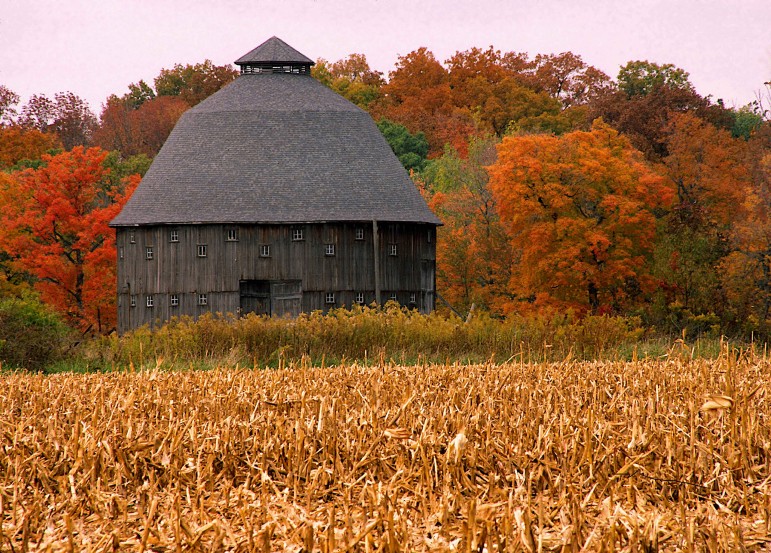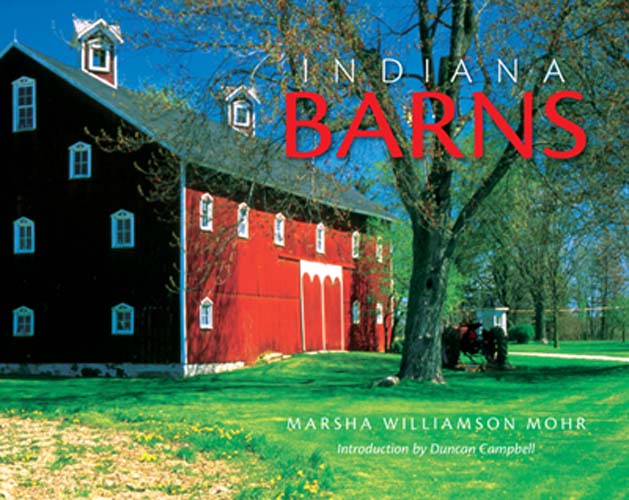
Barns in Lake County Indiana. Image: Marsha Mohr
By Juliana Moxley
Marsha Mohr credits her rural heritage for inspiring the Indiana native to photograph barns and rural scenes since around 1987.
Agriculture runs deep in her family. Her grandparents and her brother were farmers. Her father worked at Purdue University as the executive secretary of the Agricultural Alumni Association, where he promoted agriculture by giving talks throughout the Midwest and sharing new farming advancements with the public.
Her rural values came from her father, she said. And those values include a love for barns.

Marsha Mohr
“As part of growing up in a rural community, it breaks my heart as they (barns) are all crumbling,” Mohr said. “Indiana is dotted with these pastoral buildings and it’s part of our rural heritage. The absence of these would be a tragic loss for us, and for generations to come.”
Mohr’s photographs now fill up the vibrant pages of her book, “Indiana Barns.” The book was just republished in paperback. It was originally published in 2010 and won a Silver Medal for Best Nonfiction in the 2011 Independent Publishers Book Award.
The introduction and photograph captions in “Indiana Barns” are written by Duncan Campbell, a former associate professor of architecture and of the graduate program in historic preservation at Ball State University.
He was a rural carpenter early in his career and that combined with his history degree helped qualify him for the job, he said.
While at Ball State, Campbell wrote comments on books related to historic preservation, which is how he was chosen to write the introduction to Mohr’s book.
“They (the books) come to me as proposals, and one of those proposals was Marsha Mohr’s book,” he said.
Originally, Indiana University Press was going to write “generic” captions for each of the photographs, Campbell said. He wasn’t interested in doing a coffee table picture book but he wanted to do it if the book had an academic angle.

Barn in Vermillion County, Indiana. Image: Marsha Mohr
“We lucked out because Marsha took wonderful pictures, and my graduate assistant and I took it to another level,” Campbell said. “That’s why the captions are pretty specific to origin.”
Although Mohr’s book consists entirely of barn photographs, she said rural scenes are her favorite to take. Compared to only photographing barns, a rural scene takes much more skill to shoot, she said.
Still, she said the she encountered some challenging experiences while photographing barns. If it was an older barn, the property owners would question her choice for wanting to photograph it. Farmers sometimes get embarrassed that they haven’t been able to keep their barn in good shape, she said. They would prefer if it wasn’t photographed.
But that didn’t deter her from going after such subjects.
“In an artistic sense, those were my favorite to photograph,” Mohr said. “It’s rustic, artistic features with cobwebs in the windows.”
Mohr is also a registered nurse but she says that she loves being a photographer because it gives her a reason to travel. She has frequently visited Wisconsin and Ohio to photograph barns and the outdoors, but no matter where she is, she’s always trying to capture a countryside scene.

Image: Indiana University Press
“It’s funny, if we are out photographing Sedona or Olympic National Park, I’m always trying to include a rural-type building with brick or stone,” Mohr said. “To me, that’s better than having just a mountain or a waterfall.”
Mohr also enjoys preserving old barns and is a board member of the Indiana Barn Foundation.
The foundation works on ways to continue preserving barns, which is done by organizing fundraisers, increasing publicity about barn preservation, and setting up annual meetings, Mohr said.
Michigan and Iowa also have good barn preservation movements and it’s important if you have that heritage, she said.
Campbell agrees that barn preservation is important.
“As I say in the intro (of “Indiana Barns”), it’s really our story,” Campbell said. “It’s a story of how we got here, who we are, how the settlers of different origins came together on the land and met challenges of this new placed called America.”
Barns are interactions between cultures and a direct response of what people need to do to make a living and survive on the land, he said.
Campbell hopes the book helps people start or stimulate their interest in learning about barns and their capacity for remembrance.
Linda Oblack, the editor of the book at Indiana University Press, once told Campbell that a man’s two young sons really enjoyed looking at the photographs in the book. The family discussed the different barns on the landscapes, and on Sundays they would go out for a drive and try to guess what type of barn they saw based on Mohr’s book.
“Like anything that’s disappearing, you have to do anything that you can to document that,” Campbell said. “We tried to pick barns to put in the book to represent the different landscapes and typologies all across Indiana.”
Mohr’s book can be purchased in paperback for $25 at the Indiana University Press website.